This white cake is soft, fluffy, and full of classic vanilla flavor. It’s topped with a silky Swiss meringue buttercream that melts in your mouth. Simple, elegant, and perfect for any celebration, it looks beautiful on the table and tastes even better.
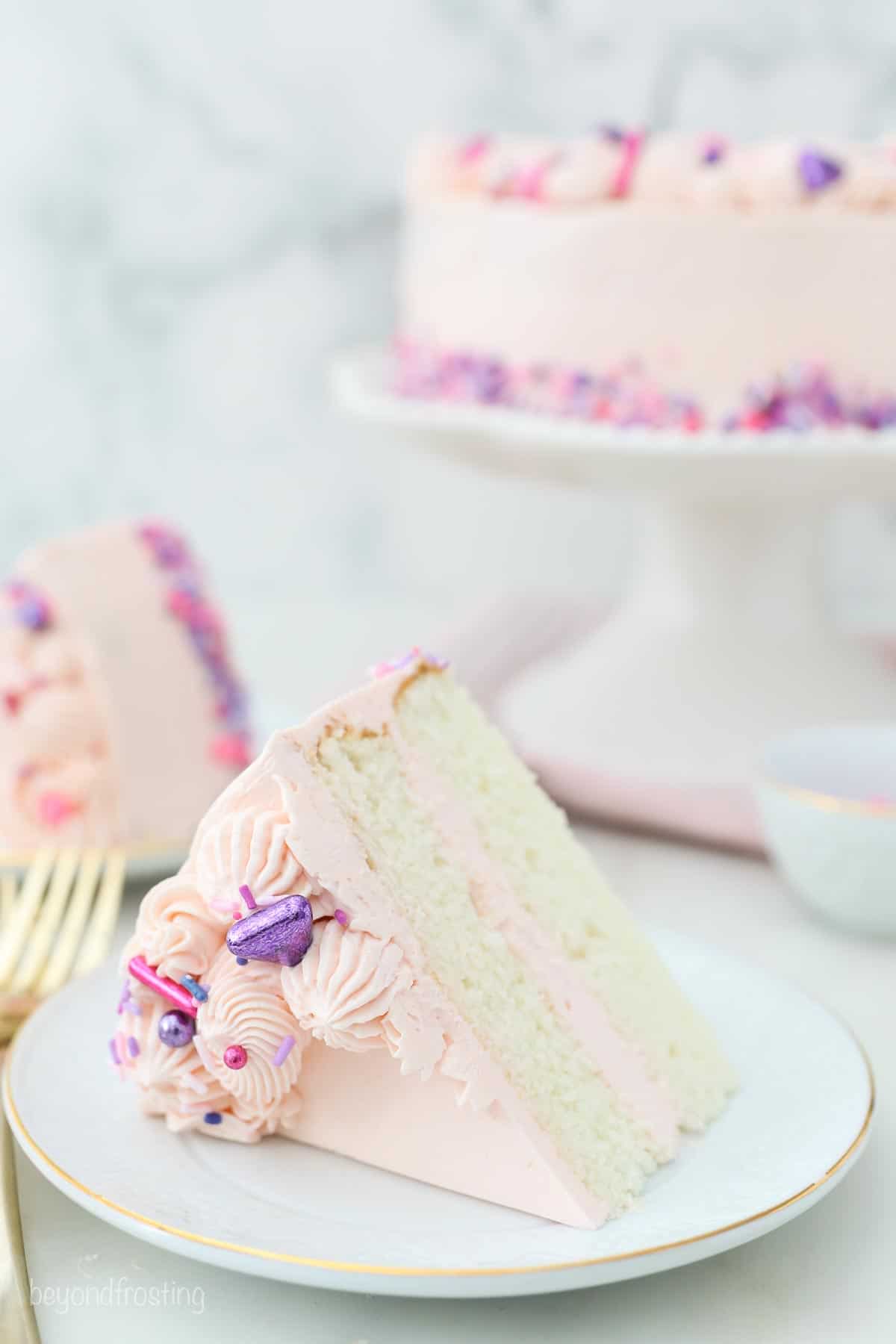
This classic white cake is light, airy, and subtly sweet, thanks to whipped egg whites and a splash of vanilla. It pairs beautifully with a smooth Swiss meringue buttercream, but you can easily swap in American buttercream or add a layer of berry jam or lemon curd for something extra. The cake itself is simple and elegant, with a delicate crumb that makes it feel special without being fussy. If you’re not super comfortable with cake decorating, feel free to leave this cake plain (this cake is stunning even without decorating). I chose to decorate it with a light pink frosting (I think it looks pretty with the pure white cake), but you can make any color frosting that you want.Although layer cakes can be intimidating to make, this recipe is very achievable!
Reasons to Fall in Love with This White Cake
- Light and fluffy texture. Whipped egg whites give the cake an airy, delicate crumb that’s soft but still holds together beautifully.
- Classic vanilla flavor. It’s just sweet enough, with a clean, simple flavor that pairs perfectly with any frosting or filling.
- Pairs with everything. Whether you use Swiss meringue, American buttercream, lemon curd, or a layer of jam, this cake works with it all.
- Easy to decorate (or not). Dress it up with piped frosting or keep it simple. This cake looks beautiful either way.
- Perfect for any celebration. It’s a timeless, crowd-pleasing cake that feels elegant without being over-the-top.
Key Ingredients
Here’s a quick look at some of the key ingredients in this recipe. Be sure to scroll to the recipe card for a complete, printable list.
- Egg Whites: Using only egg whites (no yolks) helps keep the crumb light and gives the cake that classic white color. Be sure to whip them to soft peaks before folding them in.
- Whole Milk: Adds moisture and richness to the batter.
- Cake Flour: This type of flour is extra fine and low in protein, which means it creates a softer, more tender cake. If you only have all-purpose flour, you can use it, but the texture will be a little denser.
- Food Gel Colors: Gel-based food coloring gives you vibrant color without adding extra liquid to the batter. Totally optional, but fun if you want to tint the frosting or batter for a themed celebration.
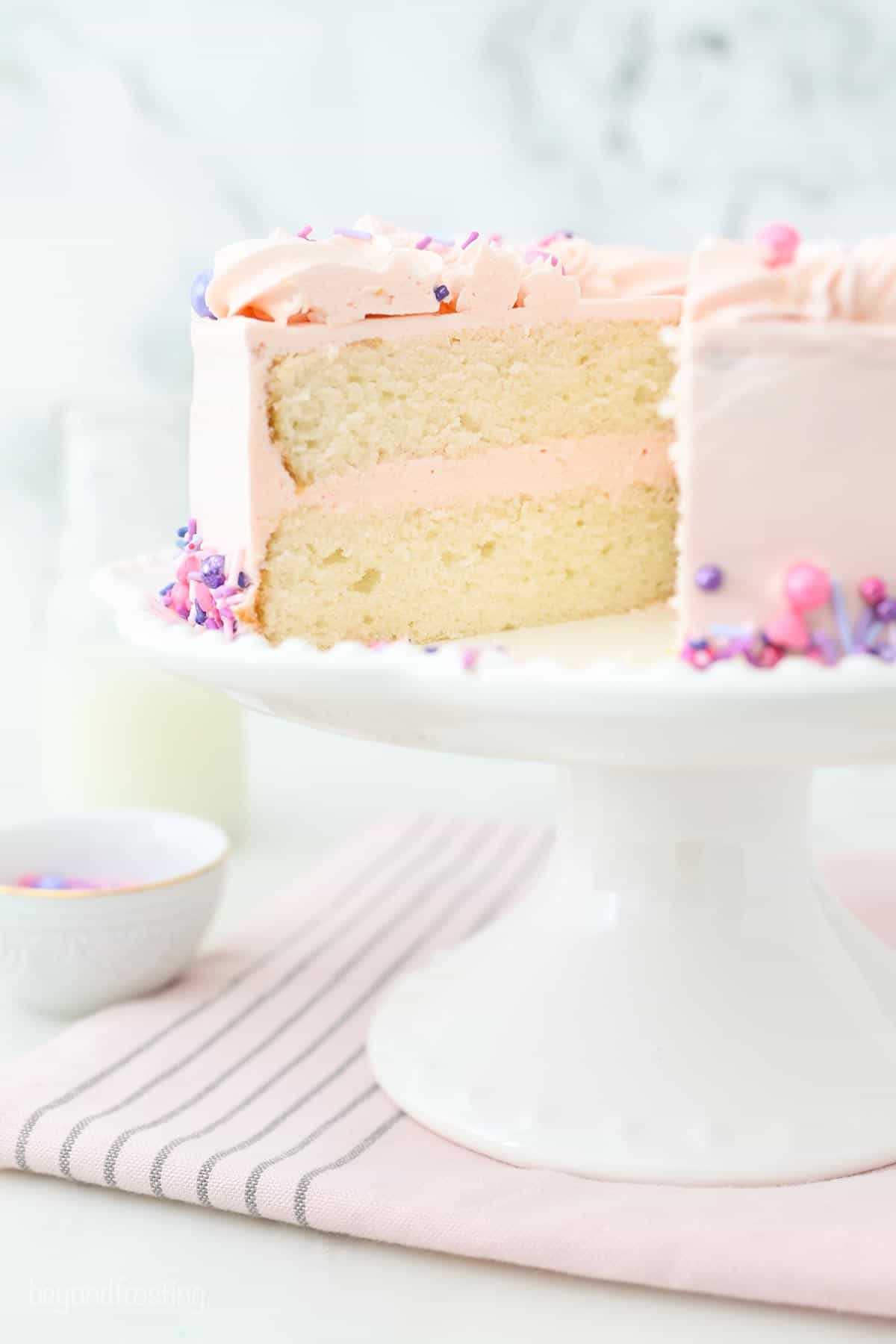
How to Make White Cake
Are you ready to make this easy white cake? Start by making sure the egg whites, milk and butter are at room temperature.
- Prep your ingredients and equipment: Prep the room temperature ingredients. Then, preheat your oven and line two 8-inch baking pans with parchment paper. Grease the sides and dust with flour to prevent sticking once the cake is baked.
- Beat the butter and sugar: In a stand mixer beat the two ingredients for a few minutes (until they are light and fluffy).
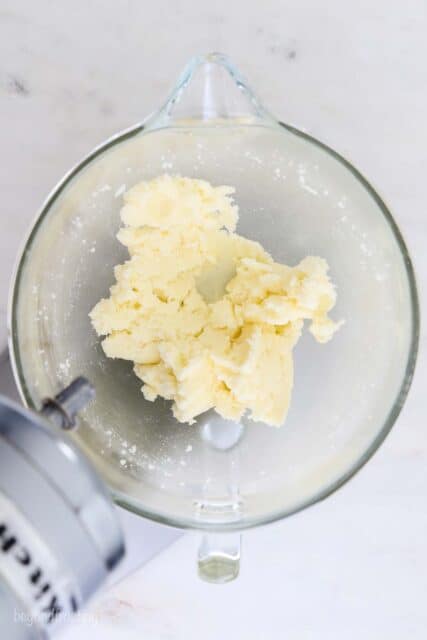
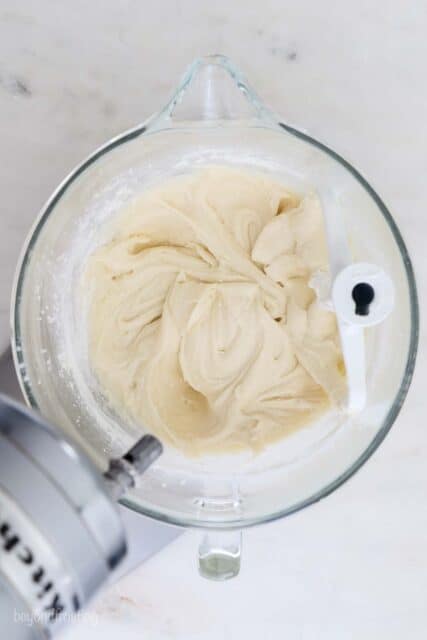
- Add the rest of the ingredients: Mix the cake flour, baking powder, and salt in a separate bowl. Then, combine the milk and vanilla extract in a measuring cup. Carefully alternate adding the milk mixture and the dry ingredients to the stand mixer. You’ll want the ingredients to be thoroughly mixed together, so I suggest using a spatula to make sure all the ingredients are fully incorporated into the batter.
- Whip and add the egg whites: Use a hand mixer to whip the egg whites until they are white, foamy and reach stiff peaks, which usually takes me about 2-3 minutes. Then, use a spatula to gently fold them into the rest of the batter (be careful not to overmix!).
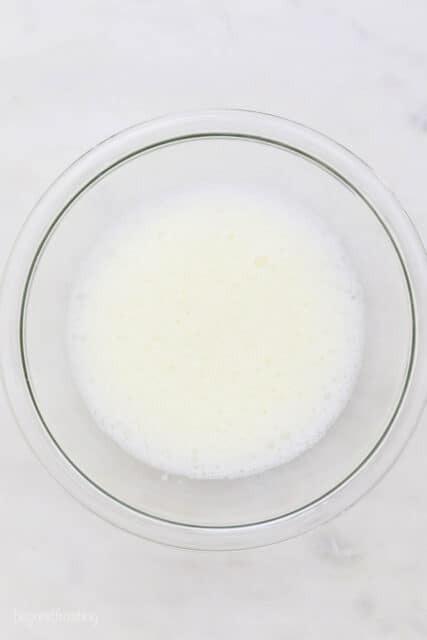
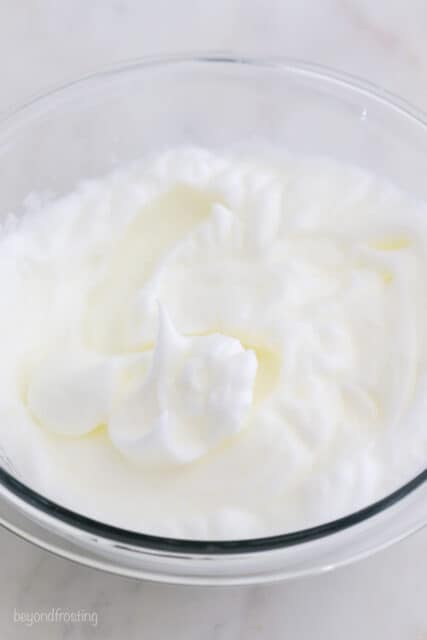
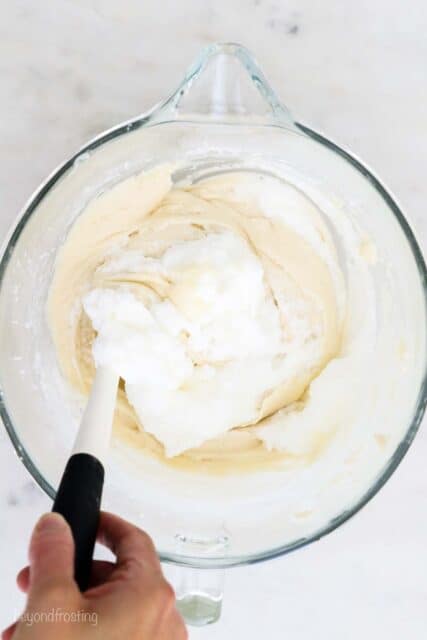
- Bake the cake: Pour the batter into the pans and bake for 23-28 minutes (or when a toothpick inserted into the center comes out clean). It’s important to allow the cake to cool completely before you start to decorate it.
How to Make Pink Frosting
While the cake is baking and cooling, you can make the Swiss Meringue Frosting. Be sure to wipe down all your utensils and bowls to remove any lingering grease, which can hinder the meringue from forming.
- Heat the egg whites and sugar: Combine the sugar and egg whites inside the bowl and attach a candy thermometer. Set the bowl on top of a pot with water covering the bottom and place it over medium heat. Stir the mixture constantly until it reaches 140-160°F (the sugar should be dissolved in the egg whites). You can test this by rubbing a drop of the mixture between your fingers, it should be smooth.
- Beat the eggs: Immediately place the mixing bowl on your stand, use a wire whisk attachment and beat at a low speed for about 2 minutes. Increase the speed to medium-high and continue beating for 5 minutes. Once the mixture has thickened to white soft peaks, increase the mixing speed again, this time to high. At this point, the frosting should start to look glossy and stiff meringue peaks will start to form. Beat for another 3-5 minutes. Touch the mixing bowl, it should be cooled.
- Add the rest of the ingredients: Turn the mixer down to medium-low. Start to slowly add the butter a couple tablespoons at a time and scrape down the sides of the bowl as needed. As you add more and more butter you might notice that the frosting starts to curdle and lose its body, but that’s okay. Once you’ve finished adding the butter switch to the paddle attachment on your mixer. Add the vanilla and food coloring and beat on medium-high for another 3-5 minutes (stiff peaks will start to form again).
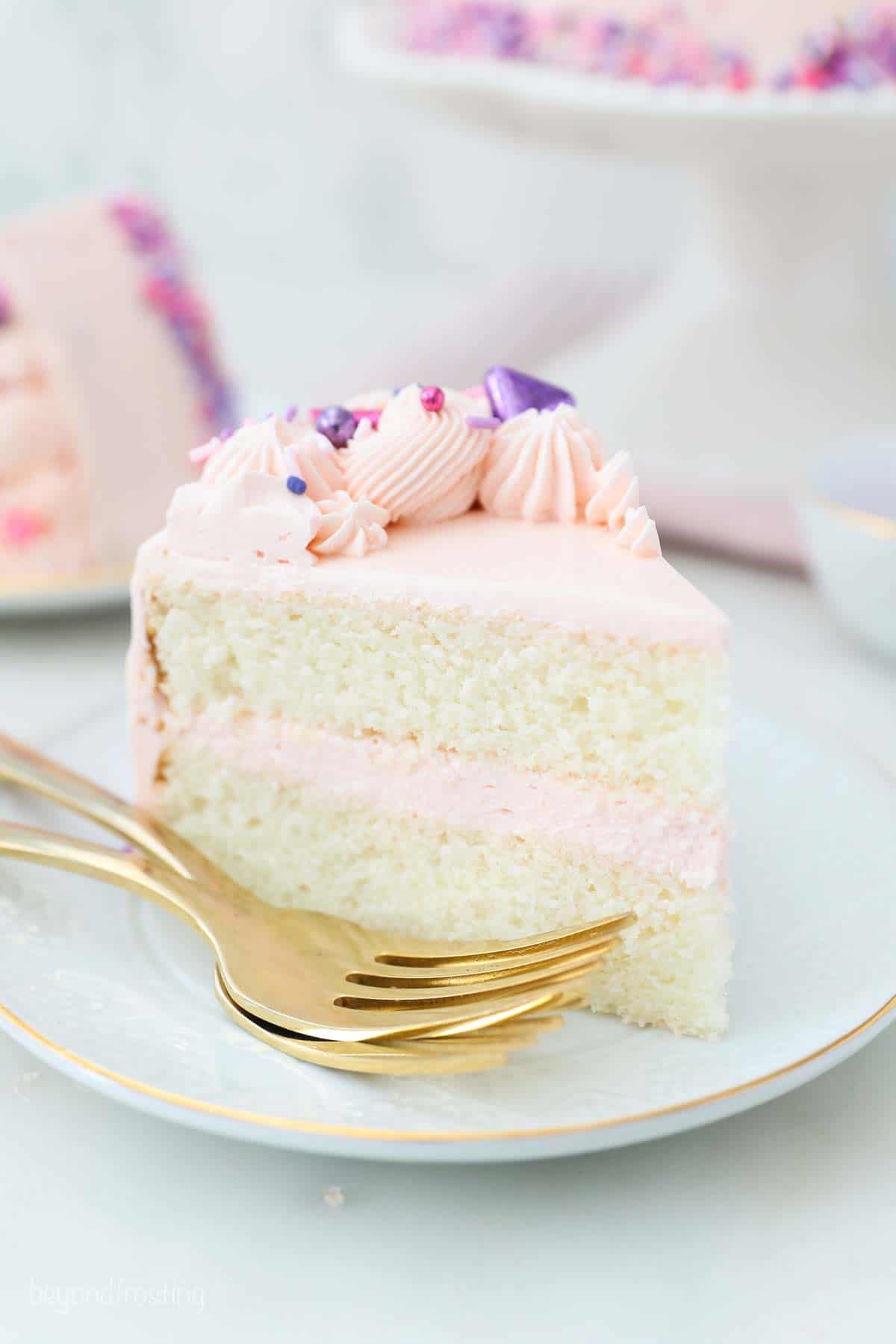
Assembling and Decorating
Once your cake has completely cooled and your frosting is ready to go, you’re ready to start assembling and decorating this two-layer cake.
- Level the cakes: Use a cake leveler to cut off any cake domes (this will make your cake more sturdy and prevent it from collapsing once it’s all frosted). Then, place a dollop of frosting on your cake board and place the first layer on top.
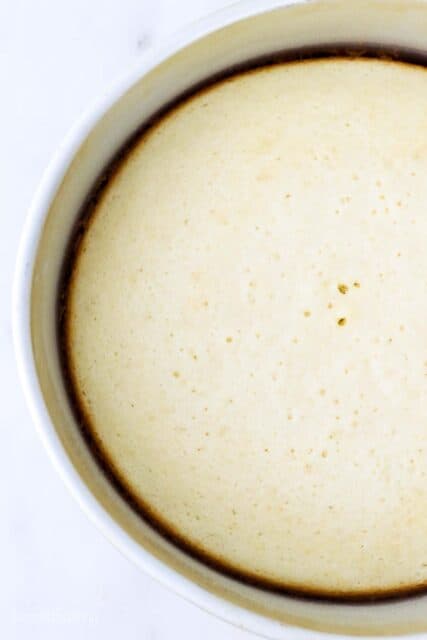

- Frost between the layers: Take about 2 cups of the frosting and insert it into a large piping bag with a large open round tip (you can also just cut the tip of the bag off). Pipe a layer of frosting onto the top of the first layer of cake, starting at the outside edge and working towards the center like a spiral. Then just spread the frosting evenly using an offset spatula and place the second layer on top.
- Make a crumb coat: Use a piping bag to fill in any holes between the layers and make a crumb coat. There will be some excess frosting, so use an offset spatula or an icing smoother to wipe it away. Make sure that you have just enough to coat the outside of the cake. If your extra frosting has cake debris in it, don’t mix it back in with the rest of your frosting!
- Frost the cake: Frost the top and sides of the cake and use an icing smoother to remove any extra frosting.
- Decorate: To decorate this cake, first pipe the roses with a 1M tip and the large rosettes with an Ateco 866. Then fill in the with the smaller tips like the: Wilton 199 and the Open star tip 21. Top with sprinkles (mine were Sweetapolita sprinkles).
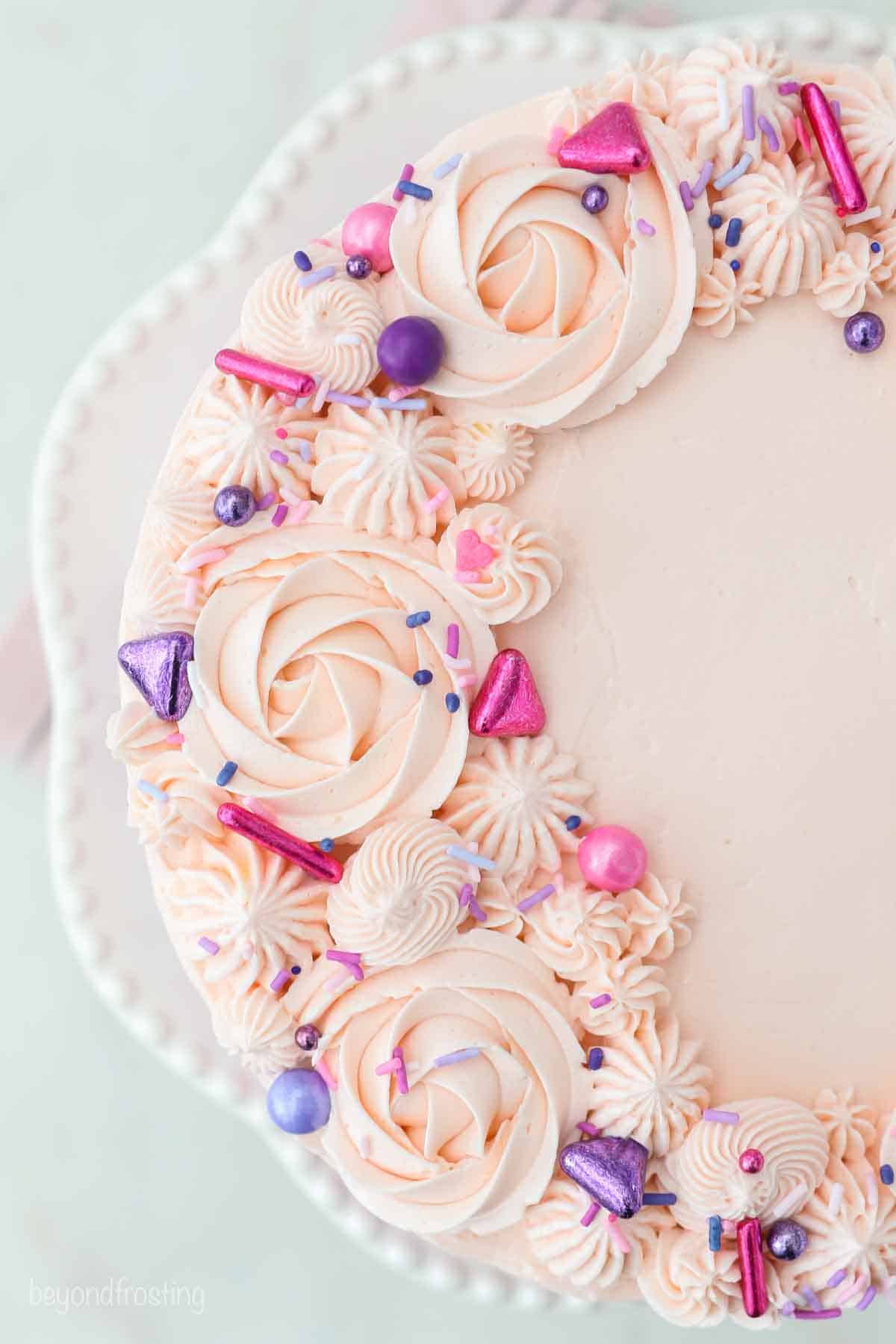
Julianne’s Tips for the Best White Cake
Although easy to make, getting the right cake texture and frosting consistency can be tricky. Here’s what I recommend that you do to make the best possible homemade white cake:
- Use cake flour: I have tested this cake with all-purpose flour and it was heavier and less moist. Make your cake light and fluffy by using cake flour instead. Just make sure to look up the brand’s weight in grams for 1 cup of cake flour when figuring out how much to use. In my research, there isn’t a straightforward weight for cake flour, and it differs by brand.
- Whip the egg whites last: Whipping the whites last will ensure that they do not deflate while you are working on the rest of the batter.
- Check that the batter is thoroughly mixed: If you pull your cakes out of the oven and notice that they sank while baking, your batter may not have been fully mixed. When you’re dividing the batter between the pans check to see if the batter is fully mixed, especially as you reach the bottom of the bowl.
- Use a toothpick before removing the cake from the oven: If you remove the cake from the oven too soon, the cake will fall and sink. Plus, the consistency and texture will be off. Instead of guessing when to remove your cake, insert a toothpick into the center. If it comes out clean, remove the cake from the oven.

How to Store a Frosted Cake
While many cakes can be left at room temperature, Swiss Meringue Buttercream is best kept refrigerated. I recommend storing this cake in an airtight container in the refrigerator for up to 5 days. The frosting will harden in the refrigerator, so make sure that you allow the cake to come to room temperature before eating it.
Can I Freeze This?
Yes, you can freeze this white cake! Just make sure that you allow the cake to cool completely before freezing. I recommend freezing individual slices so that they take less time to thaw once you are ready to eat them. The best way to do this is to line a freezer-safe container with parchment paper (this way the cake won’t stick to the sides). Allow the cake to thaw in the refrigerator overnight or on the counter for a few hours before eating. Again, this cake is best when served at room temperature. So, make sure to leave it on the counter for a few minutes if you let it thaw in the refrigerator.
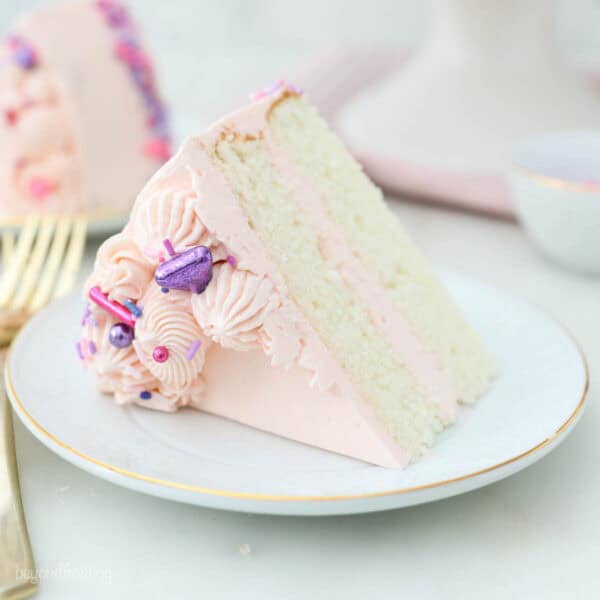
White Cake with Pink Frosting
- Prep Time: 90 minutes
- Cook Time: 25 minutes
- Total Time: 1 hour and 55 minutes
- Yield: 10 servings
- Category: Dessert
- Method: Baked
- Cuisine: American
Description
A light and fluffy white cake topped with a velvety Swiss Meringue Buttercream. This easy dessert is the perfect combination of simple and pretty!
Ingredients
For the Cake:
- 5 large egg whites, at room temperature
- ½ cup (113g) unsalted butter at room temperature
- 1 cup (236ml) whole milk at room temperature
- 2 teaspoons (10ml) pure vanilla extract
- 1 ¾ cups (333g) granulated sugar
- 2 ¼ cups (252g) cake flour (see notes)
- 2 teaspoons (7.5g) baking powder
- ½ teaspoon salt
For the Frosting:
- 5 large egg whites
- 1 cup (190g) granulated sugar
- 2 cups (452g) unsalted butter at room temperature
- 2 teaspoon (10ml) pure vanilla extract
- Food gel colors (optional)
Instructions
For the Cake:
- Separate the egg white from the yolk, ensure that no part of the yolks makes it into the eggs white. Allow the egg whites, butter, and milk to come to room temperature.
- Preheat the oven to 350°. Prepare two 8-inch round baking pans, line the bottom with parchment paper and grease the sides, lightly dust with flour.
- In a stand mixer, beat the butter and sugar together for several minutes until it’s light and fluffy. Scrape down the bowl as needed.
- In a separate bowl, combine the remaining dry ingredients: cake flour, baking powder, and salt. Then combine the milk and vanilla extract in the measuring cup. Gradually alternate adding the dry ingredients and milk to the bowl until all the ingredients have been added and are well mixed. Mix the batter with a spatula, ensuring all the ingredients on the bottom of the bowl are incorporating.
- In a separate bowl, whip the eggs whites with a hand mixer until they are foamy and stiff peaks form (about 2-3 minutes).
- Using a spatula, gently fold your egg whites into the batter. Ensure all ingredients are well incorporated but don’t overmix the batter.
- Pour the batter into the prepared pans, dividing evenly, about 2 ¼ cups per pan. Bake for approximately 23-28 minutes or until a toothpick or knife inserted into the center of the cake comes out clean. Allow the cake to cool completely.
For the Frosting:
- Wipe down the inside of your stainless-steel bowl with vinegar to remove any grease. Combine sugar and egg whites in the bowl with a candy thermometer attached.
- Set the bowl over the top of a pot with 1 ¼ cups water covering the bottom. Place over medium heat.
- Stir constantly with a whisk until the mixture reaches 140°-160° The sugar should be dissolved in the egg whites. You can test this by placing a drop on your fingertips and rubbing them together. The mixture should be completely smooth.
- Immediately place the mixing bowl on your stand. Using the wire whisk attachment, beat the eggs white on low for 2 minutes then increase to medium-high.
- Beat for another 5 minutes. At this point, your frosting should have turned white and the body of the meringue starts to form. Increase the mixing speed to high. It will start to look glossy as the peaks begin to form. Beat for another 3-5 minutes until the bottom of your bowl is cool to the touch and your meringue has stiff peaks.
- Turn your mixer down to medium-low. Slowly add your butter, 1 tbsp at a time. As you add more butter, the frosting might appear to have curdled and lost its body, that’s ok. Scrape down the sides of the bowl.
- Switch to the paddle attachment, add the vanilla extract and any food coloring you’d like, and continue beating on medium-high speed until your frosting starts to have stiff peaks. Beat for about 3-5 minutes.
To Assemble:
- Use a cake leveler to cut the domes off the top of the cake. Place a dollop of frosting on your cake board and place the bottom layer of cake on top of that.
- Place about 2 cups of frosting in a large piping bag fitted with a large open round tip, or simply cut off the end of the piping bag. Pipe a layer of frosting on top of the cake, starting at the outside edge and working your way into the middle. Spread evenly with an offset spatula. Place the next layer on top.
- Use your piping bag to fill in any gaps between your layers and to create a crumb coat. Using an offset spatula or icing smoother, wipe away the excess frosting, leaving you just enough to coat the outside of the cake. Do not mix your crumb coating frosting back into your icing if it has cake debris in it.
- Proceed to frost the top and sides of the cake using your offset spatula. Once the sides of the cake are covered, use your icing smoother to remove any excess frosting. Decorate with remaining frosting.
Notes
How to measure the cake flour: For the cake flour, go to the brand’s website or packaging and look up the weight in grams for 1 cup of cake flour to determine the final weight you need for the flour, versus using what is listed in the recipe. In my research, there isn’t a straightforward weight for cake flour, and it differs by brand.
This cake is 2 ½ inches tall frosted, each layer is about 1 inch in height
Read the full tutorial for Swiss meringue buttercream
Nutrition
- Serving Size: 1 slice
- Calories: 759
- Sugar: 55g
- Sodium: 199mg
- Fat: 46g
- Carbohydrates: 80g
- Fiber: .6g
- Protein: 6.8g
- Cholesterol: 122mg

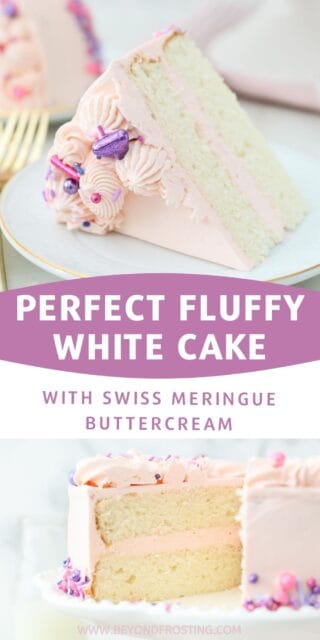


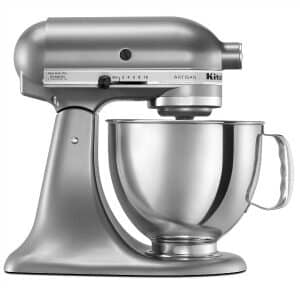
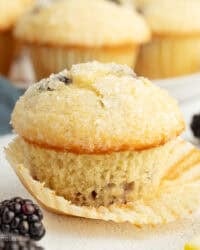
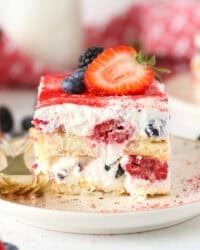

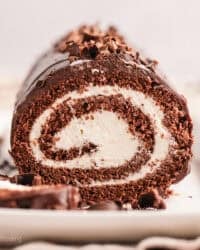
this sounds delicious. can it be made using gluten free cup for cup flour?
Hi there, usually the cup for cup flour is meant to be made with all-purpose flour. Since this recipe calls for cake flour, I am not sure the 1:1 replacement would be best here. That being said I’ve never actually tried replacing a cake flour for a 1:1 GF flour. I have tested this cake with all-purpose flour and it was heavier and less moist than the final result. So I think you’d have to try it and see if you liked it.
Thank you for the recipe! I think here in Europe an L egg doesn’t have the same weight as in US. Could you please tell me how many grams or ounces the 5 whites in the recipe weigh?
Unfortunately I have never weighed them specifically. I have 2 eggs in my fridge and I weighed the whites and it was about 31/32 grams each. So maybe around 160 grams? Give or take a little bit
Thank you! This was really helpful. Here in Spain an L egg white would weigh around 30 or even 40 g.
You’re welcome!
Hi! Can I use soy milk instead of whole milk? Trying to make this recipe vegan.
I have not tested that specifically
If I wanted to make this into a 3 layer cake instead of 2, what would I need to change my measurements to?
Hi Lauren, I would probably 1.5x the recipe, I don’t have exact measurements. What size pans are you using?
I live where I couldn’t get cake flour, is there a substitute that will work out really well as the cake flour. Thank you
Hi there, I have discussed this in the blog post itself. I did test the recipe with AP flour but it was heavier and denser. It will still bake just fine but it won’t be as light, fluffy or as moist.